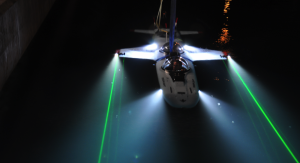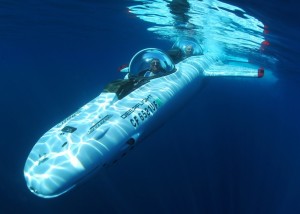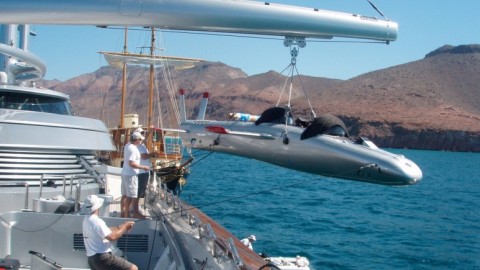Graham Hawkes can’t quite put words to the feeling. It’s like jumping off a cliff, but more peaceful. It is like sinking, but more purposeful. It is like flying but exactly the opposite.
 “Fun is an inadequate word for playing with technology the Navy doesn’t have in a part of the world were few people can go,” Hawkes explains to HuffPost Travel, somehow managing to sound more apologetic for being more verklempt than boastful about the fact that he has an underwater plane.
“Fun is an inadequate word for playing with technology the Navy doesn’t have in a part of the world were few people can go,” Hawkes explains to HuffPost Travel, somehow managing to sound more apologetic for being more verklempt than boastful about the fact that he has an underwater plane.
Graham Hawkes has an underwater plane. That is both astounding and old news. After decades building the majority of submersibles used in scientific and military missions, Hawkes and his company DeepFlight began producing underwater planes — buoyant vehicles that use hydrodynamics in much the way airplanes use the Bernoulli Principle effect — in the 1990s. It was astonishing at the time and it still is, but what might be more exciting is that Hawkes wants tourists to join him.
The sales pitch is pretty solid.
“We can move for the first time with big marine animals,” he explains, referencing the speed of his vehicles, which are considerably more maneuverable than normal submarines. “We had our first such encounter with a Great White Shark a few months back. Richard Branson was in the back…. We realized afterward that the shark had probably been challenging us over territory.”
Hawkes doesn’t so much drop names as leak them. The names of the men who dive with him should sound familiar. Director James Cameron goes on dives. Richard Branson owns a 15-foot Merlin Series dubbed the Necker Nymph in tribute to his private Caribbean island and venture capitalist par excellence Tom Perkins owns a Super Falcon — exactly like the one Hawkes pilots regularly — which he used to keep aboard the Maltese Falcon, his famed superyacht.
The reason Hawkes’ clientele is so elite is quite simple: He sells something exceptionally expensive. Even though he’s  managed to bring the price of a basic expedition down from $100,000 to $10,000, flights on his Super Falcon are not exactly affordable. It doesn’t help that his technology is so advanced that the Coast Guard forces him to give “flight lessons” instead of simple tours.
managed to bring the price of a basic expedition down from $100,000 to $10,000, flights on his Super Falcon are not exactly affordable. It doesn’t help that his technology is so advanced that the Coast Guard forces him to give “flight lessons” instead of simple tours.
Laws will catch up with technology, but bringing down costs on extremely complicated machines can be difficult — commercial aviation remained a minor industry decades after the Wright brothers crash-landed at Kitty Hawk. This didn’t stop Hawkes from settling on a goal after a recent meeting with representatives from Google and IDEO, the San Francisco design firm of the moment.
“Everyone’s feeling is that this technology is open to the billionaires club, but that we need to get the price way down for normal people,” he explains. “We hope to go toward undersea tourism. What we’ve developed so far is underwater flight and it’s fabulous. People should enjoy it.”
The hope is that a dive could eventually cost about the same as a flight on a glider or ultralight, which — on Oahu — would run a tourist between $200 and $300, a little more for longer trips. Hawkes doesn’t purport to know when that day might come, saying the proliferation of underwater aircraft will depend on funding, which might be only a year or two away.
What he is absolutely certain about is the experience he wants to share.
Hawkes wants to take passengers and pilots alike into “the twilight zone,” the area of the ocean above the inky blackness where large pelagic species hang out. Though his Falcons are now capable of diving some 3,000 feet, he says trips to that sort of depth somewhat defeat the point, which has ceased to be scientific or technical.
“Remotely operated vehicles can really play all the roles needed for science and military purposes, which frees up manned subs to be different,” Hawkes says. “It is all about the experience now. We want comfort, safety and better vision. You have this panoramic view because the domes we use couple optically with water.”
On an upcoming trip to Hawaii, Hawkes plans to join a group of new pilots watching Humpback Whales through his perfectly engineered domes. The view of the pod should be rather better from the speedy submersible than from the ships that follow the cetaceans so tourists can snap pictures of upraised flukes.
The underwater planes will be able to dive, loop and speed along with the whales.
“It is a degree of freedom humans aren’t used to,” says Hawkes, expectation leaking into his rather proper London lilt.
Even as space tourism companies get all the ink, underwater planes may call into question where the next tourist frontier actual lies: The Super Falcon is to SCUBA gear more or less what a 767 is to a good pair of walking shoes. The massive marine world could rendered suddenly accessible.
But Hawkes’ DeepFlight submersibles offer more than a chance to go someplace inaccessible. These remarkable pieces of technology may offer a specific feeling. It’s like peace but more exhilarating, like discovery but more ecstatic; something hard to describe.
By Andrew Burmon: The Huffington Post

